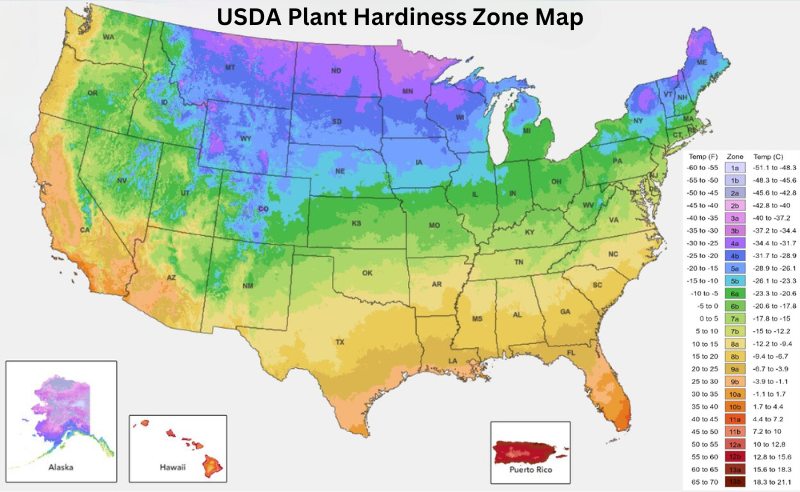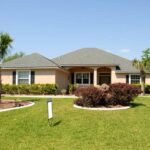
Florida-friendly landscaping ideas include using native plants, Florida-friendly vegetation, and hardscapes to conserve water, attract wildlife, and reduce runoff pollution.
From butterfly gardens and entertainment areas made with porous pavers and concrete, to how to arrange your vegetation, FFL allows Floridians to create a beautiful, interesting, and unique home landscape while preserving the Sunshine State’s natural resources.
The Principles of Florida-Friendly Landscape Design
Florida-friendly landscape design covers several landscape design principles:
1. Right Plant, Right Place

Native plants will give you a low-maintenance landscape beaming with personality. Choose plants right for your region of Florida and your landscape. Consider soil type, watering capabilities, salt proximity, and sun exposure.
Like xeriscaping, grouping plants with similar needs conserves water. Here are some plant suggestions to get you started:
Florida-friendly plants:
- Passion Flower (Passiflora)
- Red Columbine (Aquilegia canadensis)
- Buttonsage (Lantana involucrata)
- Azaleas (Rhododendron)
- Walter’s Viburnum (Viburnum obovatum)
Salt-tolerant plants:
- Florida Maple (Acer barbatum)
- Stopper (Eugenia spp)
- Inkberry (Scaevola plumieri)
- Bluestem (Andropogon spp.)
- Tickseed (Coreopsis spp.)
2. Mulch and Recycle Yard Waste

Use organic mulch to designate zones in your yard, build walkways, and create interesting garden areas in your landscape. You can even use fallen leaves and pine needles.
Place the fallen foliage in plant beds or use leaves to protect edible gardens. The foliage can help the soil stay in place through the winter and provide insulation. Just be sure to chop the leaves for circulation.
Popular organic mulch options include:
- Grass clippings
- Leaves
- Pine needles
- Eucalyptus
- Melaleuca
3. Attract Wildlife

You may live close to a natural wildlife area. Take advantage of it and adorn your Florida yard with plants and hardscapes that invite the wildlife lurking nearby.
Designating areas of your yard where you stop mowing is another way to attract wildlife. Unmowed zones create more food sources and cover. Mix plants into these areas or place a trellis in front to make it more decorative.
Hardscapes that hold water sources are also a great way to attract wildlife. Add a birdbath, a small pond, or other water features. Install decorative birdhouses and bird feeders. Just be sure to clean bird baths regularly but avoid using chemicals like bleach or soap.
Plants that attract wildlife:
- Red Columbine (Aquilegia canadensis)
- Coral Honeysuckle (Lonicera sempervirens)
- Scarlet Sage (Salvia coccinea)
- Southern Wax Myrtle (Myrica cerifera)
- Red Buckeye (Aesculus pavia)
4. Minimize Stormwater Runoff

Make rainfall work for you by building and installing structures that retain water or slow runoff, allowing it to be absorbed by the soil and plants.
Extend your living space into the beautiful outdoors with patios, decks, walkways, and paved seating areas. Create geometrically shaped or multi-colored walkways. Use porous gravel, pavers, and concrete. Reprocessed, reclaimed, or materials made from recycled materials are also Florida-friendly. Even driveways can be made with porous materials.
Rain barrels. Place a rain barrel by the downspouts. Your UF/IFAS Extension office has information on using rain barrels and may even have programs that offer containers.
And don’t worry. You won’t be stuck with an ugly barrel sticking out like a sore thumb. There are lots of ways you can – to borrow from MTV – pimp your rain barrel to make it aesthetically pleasing.
Paint it the same color as your home, a complementary hue, or design it like a mural. You can also use rain chains. They come in different colors and styles.
5. Protect Florida’s Waters

If you have a waterfront property, use swales and berms to slow rainwater runoff. Shape small channels into the ground, or swales, and create raised areas, or berms, that run parallel to the water’s edge.
Make sure you build these natural structures above the high-water line. Put your barrier zone next to the swale and fill it with native plants and Florida-friendly vegetation. (Make sure you are adhering to local ordinances for buffer mandates).
Plants that work well in swales and barrier zones include:
- Pop Ash (Fraxinus caroliniana)
- Virginia Willow (Itea virginica)
- Buttonbush (Cephalanthus occidentalis)
- Florida Gama Grass (Tripsacum floridana)
- Cinnamon Fern (Osmunda cinnamomea)
How to Incorporate Florida-Friendly Design Principles

A Florida-friendly landscape empowers you to choose from many different styles, from garden types to plant types like groundcovers and wildflowers.
Best butterfly garden plants for Florida:
- Black-eyed Susan (Rudbeckia hirta)
- Florence Fennel (Foeniculum vulgare var. azoricum)
- Necklace Pod (Sophora tomentosa subsp. truncata)
- Passion Flower (Passiflora incarnata)
- Blazing Star (Liatris)
Florida natives:
- Azaleas (Rhododendron)
- Violets (Viola)
- Passion Flower (Passiflora)
- Beautyberry (Callicarpa americana)
- Muhly Grass (Muhlenbergia capillaris)
Florida wildflowers:
- Tickseed (Coreopsis spp.)
- Red Columbine (Aquilegia canadensis)
- Elliott’s Aster (Symphyotrichum elliottii)
Fill Space Quickly

Use plants with large, variegated leaves for spaces that you want to fill up without the work and effort of multiple plants. Large plants with a large spread, like a cascading or irregular pattern, also fill a space quickly. And, they create visual interest.
Vegetation with interesting leaves instead of petals is a low-maintenance alternative to flowers. Flowers typically require more maintenance, while plants with large foliage do not.
Here are some plants with large, colorful, and diversely textured and shaped leaves:
- Copper Leaf (Acalypha wilkesiana)
- Croton (Codiaeum variegatum)
- Monkey Grass (Liriope muscari)
- Shell Flower (Alpinia spp.)
- Fakahatchee Grass (Tripsacum dactyloides)
Ground cover is also a great option for covering a lot of space. They need minimal maintenance like pruning. Some great Florida-friendly options include:
- Japanese Ardisia (Ardisia japonica)
- Holly Fern (Cyrtomium falcatum)
- Perennial Peanut (Arachis glabrata)
Create Shade

Make windows and air conditioning units more energy efficient by planting trees nearby to cast shade. Trees and shrubs also provide shade for plants growing beneath them. Smaller trees shed fewer leaves and the fallen foliage blends in with the vegetation below or can be used as mulch.
Popular small trees and large shrubs in Florida include:
- Pindo Palm (Butia capitata)
- Sea Myrtle (Baccharis halimifolia)
- Powderpuff (Calliandra spp.)
- Copper Leaf (Acalypha wilkesiana)
- Pineapple Guava (Acca sellowiana)
- Leather Fern (Acrostichum danaeifolium)
Combine Hardscapes and Greenery
Let your Florida-friendly landscape design turn your outdoor space into an at-home retreat. Don’t just implement elements that help preserve natural resources, create a space where you can entertain and relax year-round.
Choose outdoor furniture and materials that are durable and low-maintenance. Place container plants on patios, and use pergolas, arbors, awnings, or trellises to create shade. You can also hang plants from the top of pergolas or use climbing plants on trellises.
Florida-Friendly Landscaping Tips
- Group plants with similar needs that grow at different heights for vertical layering. For example, a combination of ground covers, flowers, ornamental grasses, and shrubs will create vertical interest.
- Add interest with planters or raised garden beds around patios, seating areas, or other locations in your yard.
- Install pathways, garden walls, or low retaining walls between plant beds to create sections and increase functionality.
- Repeat plant designs in different areas of your yard for uniformity.
- Use plants that are shaped or will grow to the shape of the space they are occupying. This will reduce the time you have to spend trimming them to fit the space.
- Use edging to keep soil and mulch in place and create aesthetic appeal.
- If you have an area where water accumulates, you can excavate the area and fill the bottom with rocks or make it a rain garden.
How to Choose Florida-Friendly Plants

Plant selection should be based on the climatic conditions of the Florida region where you reside and your yard’s conditions. It should also be based on which plants are non-invasive to your area. For example, the royal poinciana tree grows in South Florida, but it may also be invasive.
Here are things to consider:
USDA plant hardiness zone: Your planting zone lets you know which plants can survive your area’s coldest winter temperatures. Florida is in zones 8 to 11.
Soil condition: Know your soil type and which plants thrive in your soil’s composition, or amend your soil with compost when necessary. Your county extension office can help you identify your soil type or provide soil testing.
Light: Understand how sunlight affects your property so you plant tolerant flora.
Water: Be familiar with whether your yard has areas where water is slow to drain or accumulates.
FAQ About Florida-Friendly Landscaping Ideas
What is Florida-friendly landscaping?
Florida-friendly landscaping is a joint venture by the University of Florida’s Institute of Food and Agricultural Sciences (UF/IFAS) and the Florida Department of Environmental Protection to protect Florida’s natural resources and conserve water.
The FFL Program offers resources that educate and help homeowners implement sustainable and environmentally friendly landscaping strategies, plants, and other materials. The program aims to conserve water, prevent erosion, reduce waste and pollution, and provide wildlife habitats.
How much mulch should I use in plant beds?
Use 2 to 3 inches of mulch. When using mulch around tree trunks, leave about 2 inches of space around the trunk to minimize the risk of rot.
Are there restrictions on FFL?
In 2009, Florida instituted a law prohibiting HOAs and local governments from stopping homeowners from making their landscape Florida-friendly. However, your HOA may have guidelines and require approval before making changes. Inquire with your HOA before modifying your Florida yard.
What else can I do to make my home landscape Florida-friendly?
Install an automatic irrigation system with rain sensors and only water when your plants and lawn need it. Additionally, use integrated pest management to manage yard pests.
IPM uses as few chemicals as possible to reduce runoff into Florida waters, helping to manage water quality. It also keeps nearby plants from being damaged by harmful pesticides.
When to Hire a Landscaping Professional
Like any other landscaping effort, FFL design has many options. There are a lot of things to consider, from sustainable plants and materials to your property’s conditions. You can do the research and watch YouTube videos, or you can allow an expert to do all of the work while you reap the benefits.
Selecting a professional means making sure they are familiar with how to design a Florida-friendly landscape. LawnStarter has all the connections you need to create a Florida-friendly yard you can be proud of. Let LawnStarter connect you to a Florida landscaping professional near you today. Whether you’re in Jacksonville, Miami, Tampa, St. Petersburg – or anywhere else in the great state of Florida – LawnStarter can connect you with passionate lawn care and landscaping pros with helpful advice.
Main Photo Credit: TerryJ / Canva Pro / License





